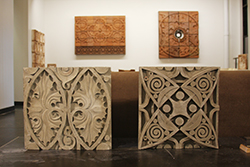Architecture students explore craft in digital era

LAWRENCE — Can architecture students using 21st-century technology turn out something as beautiful as the master designers and craftsmen of the 19th century did?
And might the experiment lay the foundation for a digital library that would allow people to see and replicate modern copies of historical building details?

That was what University of Kansas School of Architecture, Design & Planning Assistant Professor Keith Van de Riet wanted his third-year students to explore in his fall class called “Craft in the Digital Age.” He directed them to create full- and half-scale models of the terra-cotta (i.e., architectural ceramics) ornaments found on Louis Sullivan’s landmark Wainwright Building in St. Louis, one of the nation’s first skyscrapers.
“It’s modeled after the methods of the Beaux Arts School in the 18th century, which is really the source of American architecture,” Van de Riet said. “There, the students copied classical details – Ionic, Doric and Corinthian columns, for example – until they internalized the lessons. Now with the digital tools we have, I wanted to test those tools and the students’ knowledge of the tools with a deep precedent of historical analysis.”
The 16 students were divided into four groups of four students each for the semester-long project. Two groups replicated the leaf-filled circles found on the 10-story building’s cornice – that’s the horizontal decorative molding that crowns a building – one chose to recreate the decorative panel below each ninth-story window, and the last group copied the tiles that wrap around the first-floor entry door.
Van de Riet said few of the plans for the Wainwright Building itself — and none for the details — have survived. Nor is it easy to get eye-level photos of the upper-floor detailing. So the students used what photos they had and employed 3-D modeling software to compensate. Those drawings were translated into positive models – some created with a 3-D printer and some cut from foam blocks with a router. Negative molds were then created in plaster or silicone rubber, and those molds were filled by hand with clay, plaster or cast stone.
The dry clay pieces were then fired in a kiln housed at KU’s Department of Visual Art in collaboration with Marshall Maude, associate professor of ceramics.
“It was a challenge for them as well,” Van de Riet said. “They had never done architectural work before.”
The students also built steel frames from which to hang their creations, which are currently displayed on the walls of the first-floor common area of Marvin Hall, which houses the architecture school.
Van de Riet said terra cotta has had a resurgence in the past decade.
“The students also learned about how a façade works; about mocking up a piece of a façade … to show contractors and subcontractors what it will actually look like,” he said.
Nor are students the only possible beneficiaries of the exercise, Van de Riet said. The techniques they used could be used to replicate other historical architectural details, creating a catalog of such forms that could be made available publicly.
“People could download 3-D models and print them at a library,” he said. “The community could access it.”
The student participants were Kelechi Akwazie, David Brookman, Alex Delekta, Cassandra Hall, Jacob Hansen, Joseph Herdler, Andrew Hutchens, Maxwell Irby, Mark Kaufman, Grace Kennedy, Joseph Libeer, Benjamin Marquardt, Andrew Marquette, Andy Martinez Renteria, Jacob Peterson and Dana Ritter.